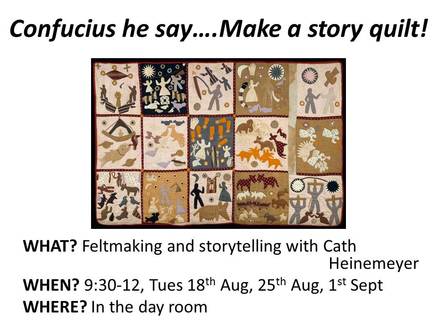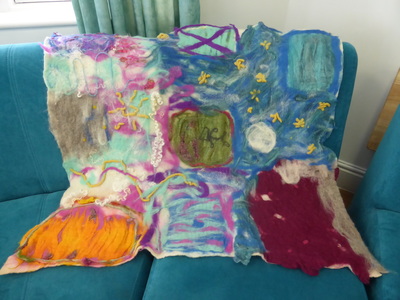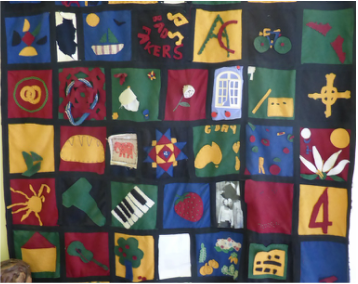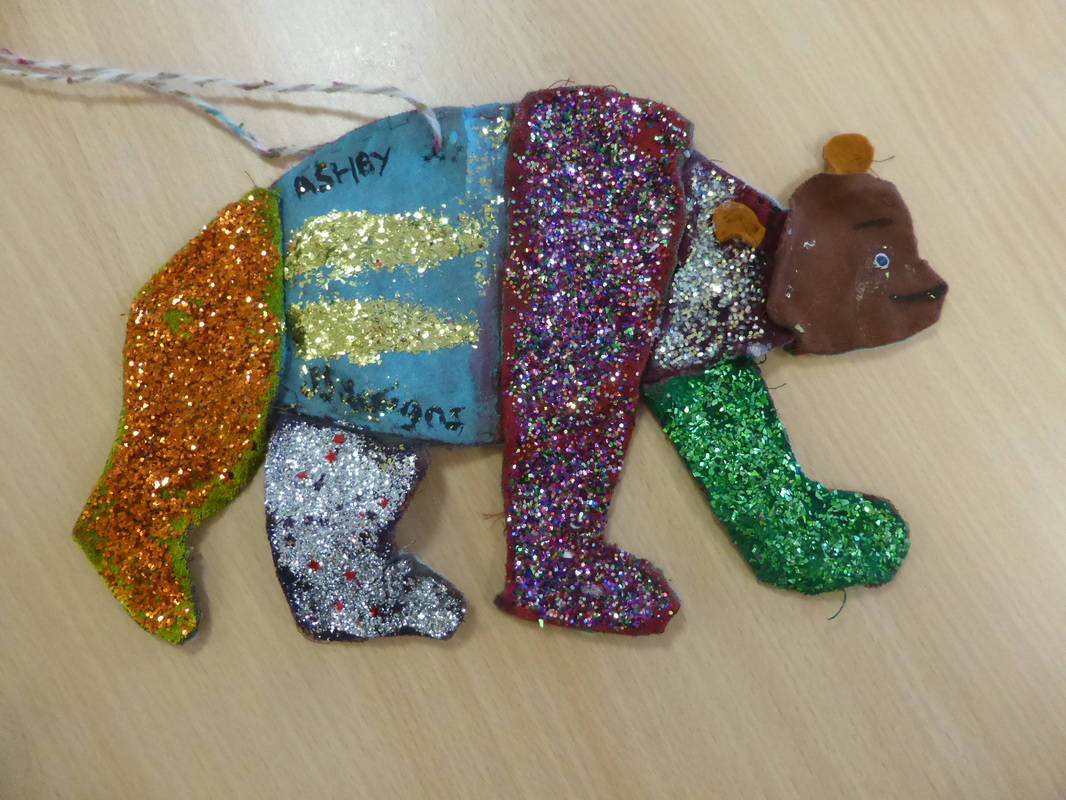It's not about the story at Maple House
Lawrence Millman interviewed many elderly people who recalled storytelling ceilidhs in their youth: ‘It was not the story that was in it,’ one old man told me. ‘Not the story really at all, but the idea you were passing your time with the others” (1977:78-79). Handcrafts and whispering in corners were a fundamental part of the 'vernacular' of such ceilidhs (Alexander Carmichael, cited in Katharine Briggs 1977:3); that is, the agreed social practices of how to behave at a storytelling event, what made it hang together. In fact I often brought handcrafts to Maple House for young people to busy their hands with while listening to stories. However, after a particularly difficult period during which participation in my sessions had tailed off and I began to doubt the role of storytelling in this setting, I decided to start with a series of craft workshops and let the storytelling emerge of its own accord, if it wanted to. It did.
I include this somewhat meandering 'story of practice' to show that a storytelling practice with young people is not always about an epic story, but developing a 'vernacular', specific to that place and those people, within which storytelling can arise. A responsive practice builds on their natural conversational storytelling, the 'offers' they make almost casually, and can ascend what Ben Haggarty (2014) has called the 'ladder to the moon', step by tentative step. Customs form, comfort and confidence build, providing a 'cushion' around the interpersonal intensity of storytelling. In Maple House, with its transient population and ever-shifting dynamics, such a 'vernacular' can only ever endure for a short time - weeks or a few months at most - before it is no longer the property of those present. The hard thing for me as storyteller is to observe that moment, when things are no longer 'working', and start listening very hard again for what the current group might be able to develop for itself.
See 'Maple House' for an overview of my practice in this setting.
I include this somewhat meandering 'story of practice' to show that a storytelling practice with young people is not always about an epic story, but developing a 'vernacular', specific to that place and those people, within which storytelling can arise. A responsive practice builds on their natural conversational storytelling, the 'offers' they make almost casually, and can ascend what Ben Haggarty (2014) has called the 'ladder to the moon', step by tentative step. Customs form, comfort and confidence build, providing a 'cushion' around the interpersonal intensity of storytelling. In Maple House, with its transient population and ever-shifting dynamics, such a 'vernacular' can only ever endure for a short time - weeks or a few months at most - before it is no longer the property of those present. The hard thing for me as storyteller is to observe that moment, when things are no longer 'working', and start listening very hard again for what the current group might be able to develop for itself.
See 'Maple House' for an overview of my practice in this setting.
 Poster for the feltmaking sessions Poster for the feltmaking sessions
Extract from my fieldnotes:
'I show them my wedding quilt (each guest made a square) and tell (clumsily perhaps) about why we made it and some of the tensions in it – the people who did not get on, the language difficulties, the irreverent squares added, my inability to remember what some of the squares mean – yet how it still seems to me to tell the story of who we were back then and our friendships. I do not want it to seem a thing of perfection or smugness – but I want them to know I love it anyway. I show them other story quilts from different cultures. I am surprised how ready and willing they are to get straight down to work making our own six-part quilt, and how much they love the story they make up to represent on it. We do this as a 'chain story', usually guaranteed to produce random subversiveness, but this one is simple and childlike.' Our simple 'chain story':
A boy who loved ice-cream was in a park and met a bird, with whom he shared his ice-cream. The bird led him to a low-doored ice-cream shop, with a strange old man in it. The man told him the story that had come down through his family about how ice-cream is made. A flood of ice-cream suddenly came up, but the man had a boat. They sailed away on the flood til they came to an island. There the boy found many other flavours of ice-cream, which he brought back. He took over the shop from the old man and made the most incredible ice-cream ever. And he gave the first taste to the bird. Someone pointed out that it was a 'hero's journey' story. We discussed at length: is it possible to create a story that isn't? This story would be re-told many times, mostly by me, during the next three weeks, each time accreting more images and emphases that were building up as we went. Working on the quilt reminded me of the story of Penelope, Odysseus’ wife who worked each day on her father-in-law’s shroud (unpicking it later at night) to postpone the day when she would have to choose a new husband. I told them this story, and then Carol Ann Duffy’s take on Penelope, describing her becoming enamoured of the creative act of sewing itself. They wanted to hear this poem again, and one girl offered to scribe (in beautiful calligraphy) some phrases from it - they chose:
‘disturbed my peace’
‘I chose between three greens for the grass’ ‘my thimble like an acorn’ ‘whole days had passed without my noticing’ ‘the loose gold stitching of the sun’ ‘walnut brown for a tree’ |
In July 2015 a reflective dialogue with the setting's teachers explored the barriers that prevented many young people engaging in my storytelling sessions: the fact that some stories touched too closely onto difficult personal issues; the fear that some performance might be expected of them in return; the physical constraint of sitting and listening. Needing a change of tack, I decided to spend the summer's sessions on an activity low in intensity and high in undemanding beauty: feltmaking.
As one girl expressed a wish to make the setting more homely, we decided to work together on a quilt for the dayroom. Individuals first made their own individual areas to learn the technique, then collaborated on the design for the interspersing areas, choosing a simple ‘narrative’ of brightness fading into starry nighttime. While we worked they told each other what their sections reminded them of; we chatted and shared views, stories, even poetry. These sessions built trust, helped me to get to know the current group of residents, and generated ‘offers’: “I would like to know what the storytelling sessions are like.” “They’re fun, we play games….” Encouraged by this invitation, I thought we might proceed via storytelling games to our own more narrative story quilt. I brought other story quilts for inspiration. Meanwhile our 'common languages' diversified and developed...One girl asked me to bring my guitar next week, when she picked out chords for a song based on our story quilt...
Others asked for other instruments or brought their own... Others made up skits using the more flamboyant fabrics... Another started decorating my half-finished craft projects using my children's old clothes... |
|
I asked each young person or pair to take one scene from the quilt and generate some words or phrases it called to mind for them – not necessarily about the specifics of the story, but the essence of the scene. Most came up with words and phrases of emotion. One pair came up with a whole spoof scat of the whole story: ‘There was a lad / Who was so rad / etc….’ – which I said could be the Greek chorus. Some pairs chose one or two of the Duffy lines to go with their scene and words. We shaped it into a song (the Greek chorus was unanimously eliminated). One boy, without being asked, took over as lead singer and we recorded it (watch/listen to Youtube clip to right), and performed it for the staff. The sense of collective achievement was palpable.
|
|
Had we created a 'vernacular'?
Perhaps not. Some of these young people never became so involved again in storytelling sessions - whether because I failed to hit the mark in future workshops, because they had given what they could for now, because the mood in the setting had changed with new arrivals and departures, or some other factor. This episode called to mind Nicolas Bourriaud's (1998) concept of the 'microtopia' - a relational artistic space which does not prefigure a better future, but rather is in itself an island of genuine and unusual human contact. If durable 'vernacular' storytelling institutions (such as Millman describes) are elusive in settings like Maple House, and throughout much of our culture of multiple and shifting identities, perhaps periods of confluence and collaboration like these need to be valued for their own sakes. Perhaps the difference between a 'vernacular' and a 'microtopia' is that the latter makes no promise to endure.
It was salutary for me to observe that, while my practice research foregrounds the potential of epic narrative, the stories which established and thrived in this space were my own 'small' stories of family life, and those of the young people. Indeed these stories may have appealed to young people who found the grander repertoire difficult for a variety of reasons. A dialogic, participatory practice of storytelling with young people needs to be alive to these different affinities of groups of young people, and what is called for in different moments of practice.
It was salutary for me to observe that, while my practice research foregrounds the potential of epic narrative, the stories which established and thrived in this space were my own 'small' stories of family life, and those of the young people. Indeed these stories may have appealed to young people who found the grander repertoire difficult for a variety of reasons. A dialogic, participatory practice of storytelling with young people needs to be alive to these different affinities of groups of young people, and what is called for in different moments of practice.
Postscript: It's not about the story - but is it therapy?
This sequence of sessions started far from my usual repertoire and ended up in unusual territory, a song in the language of emotions and personal significance. In its outward details it therefore resembled a 'therapeutic' project and led me to reflect on a boundary that can seem 'fuzzy' in work in therapeutic settings:
Is my storytelling practice at Maple House simply the ‘lightest’, most distanced and unthreatening form of dramatherapy or occupational therapy, on a kind of spectrum of interventionism? In claiming to have an artistic rather than a therapeutic practice, am I simply making a virtue of my deficit of professional qualification as a therapist? Or is there a distinctive practice I can articulate that has its own boundaries, rationale and forms?
There are certainly overlaps, but this sequence of workshops also highlighted important differences between my practice and a therapeutic one, as laid out in texts such as Renee Emunah's (1994) 'Acting For Real'. In working with this group of young people I did not ‘set up a safe space’, have any kind of plenary at the end, talk explicitly about our goals or norms. The aesthetic was of extreme informality, conversation, play, fun. In contrast with a drama therapy session, the sessions were relatively unstructured by me, and none of us knew quite what to expect, something that undoubtedly made the young people nervous at times. I was reliant on their offers, and guided primarily by their interests and talents.
Is my storytelling practice at Maple House simply the ‘lightest’, most distanced and unthreatening form of dramatherapy or occupational therapy, on a kind of spectrum of interventionism? In claiming to have an artistic rather than a therapeutic practice, am I simply making a virtue of my deficit of professional qualification as a therapist? Or is there a distinctive practice I can articulate that has its own boundaries, rationale and forms?
There are certainly overlaps, but this sequence of workshops also highlighted important differences between my practice and a therapeutic one, as laid out in texts such as Renee Emunah's (1994) 'Acting For Real'. In working with this group of young people I did not ‘set up a safe space’, have any kind of plenary at the end, talk explicitly about our goals or norms. The aesthetic was of extreme informality, conversation, play, fun. In contrast with a drama therapy session, the sessions were relatively unstructured by me, and none of us knew quite what to expect, something that undoubtedly made the young people nervous at times. I was reliant on their offers, and guided primarily by their interests and talents.
References:
- Briggs, K.M. 1977. British Folk-tales and Legends: A Sampler. Paladin Books.
- Bourriaud, N. 1998. Relational Aesthetics. Les presses du reel.
- Emunah, R. 1994. Acting for Real: Drama Therapy Process, Technique and Performance. New York: Brunner/Mazel Inc.
- Haggarty, B. 2014. "The Ladder to the Moon: the progression of stories and narrative sequencing in performance." Accessed July 2014. http://www.crickcrackclub.com/MAIN/LADDER.PDF
- Millman, L.1977. Our Like Will Not Be Here Again: Notes from the West of Ireland. Saint Paul, Minnesota: Ruminator Books.


